Phee Lep Yeoh
Secure Enhancement for RIS-Aided UAV with ISAC: Robust Design and Resource Allocation
Sep 25, 2024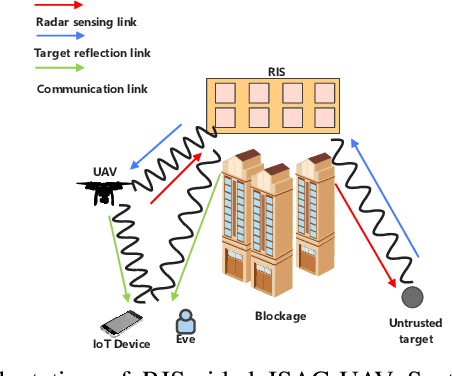

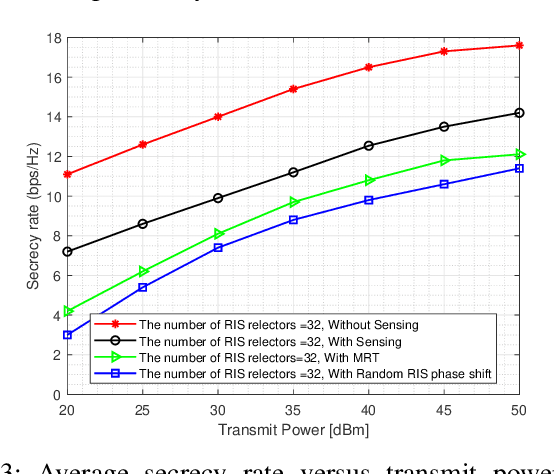

Abstract:This paper analyses the security performance of a reconfigurable intelligent surface (RIS)-aided unmanned aerial vehicle (UAV) communication system with integrated sensing and communications (ISAC). We consider a multiple-antenna UAV transmitting ISAC waveforms to simultaneously detect an untrusted target in the surrounding environment and communicate with a ground Internet-of-Things (IoT) device in the presence of an eavesdropper (Eve). Given that the Eve can conceal their channel state information (CSI) in practical scenarios, we assume that the CSI of the eavesdropper channel is imperfect. For this RIS-aided ISAC-UAV system, we aim to maximize the average communication secrecy rate by jointly optimizing UAV trajectory, RIS passive beamforming, transmit beamforming, and receive beamforming. However, this joint optimization problem is non-convex due to multi-variable coupling. As such, we solve the optimization using an efficient and tractable algorithm using a block coordinate descent (BCD) method. Specifically, we develop a successive convex approximation (SCA) algorithm based on semidefinite relaxation (SDR) to optimise the joint optimization as four separate non-convex subproblems. Numerical results show that our proposed algorithm can successfully ensure the accuracy of sensing targets and significantly improve the communication secrecy rate of the IoT communication devices.
Movable Antenna Enabled ISAC Beamforming Design for Low-Altitude Airborne Vehicles
Sep 24, 2024Abstract:In mobile systems with low-altitude vehicles, integrated sensing and communication (ISAC) is considered an effective approach to increase the transmission rate due to limited spectrum resources. To further improve the ISAC performance, this paper proposes a novel method called integrated sensing and communication-movable antenna (ISAC-MA) to optimize the antenna's position. Our goal is to support low-space vehicles by optimizing radar and communication joint beamforming and antenna position in the presence of clutter. This scheme not only guarantees the required signal-to-noise ratio (SNR) for sensing but also further improves the SNR for communication. A successive convex approximation (SCA)-based block coordinate descent (BCD) algorithm is proposed to maximize communication capacity under the condition of sensing SNR. Numerical results show that, compared with the traditional ISAC system and various benchmark schemes, the proposed ISAC-MA system can achieve higher communication capacity under the same sensing SNR constraints.
Improving Physical-Layer Security in ISAC-UAV System: Beamforming and Trajectory Optimization
Sep 22, 2024



Abstract:This paper investigates a novel unmanned aerial vehicle (UAV) secure communication system with integrated sensing and communications. We consider wireless security enhancement for a multiple-antenna UAV transmitting ISAC waveforms to communicate with multiple ground Internet-of-Thing devices and detect the surrounding environment. Specifically, we aim to maximize the average communication secrecy rate by optimizing the UAV trajectory and beamforming vectors. Given that the UAV trajectory optimization problem is non-convex due to multi-variable coupling develop an efficient algorithm based on the successive convex approximation (SCA) algorithm. Numerical results show that our proposed algorithm can ensure the accuracy of sensing targets and improve the communication secrecy rate.
Graph Neural Network-Based Bandwidth Allocation for Secure Wireless Communications
Dec 13, 2023Abstract:This paper designs a graph neural network (GNN) to improve bandwidth allocations for multiple legitimate wireless users transmitting to a base station in the presence of an eavesdropper. To improve the privacy and prevent eavesdropping attacks, we propose a user scheduling algorithm to schedule users satisfying an instantaneous minimum secrecy rate constraint. Based on this, we optimize the bandwidth allocations with three algorithms namely iterative search (IvS), GNN-based supervised learning (GNN-SL), and GNN-based unsupervised learning (GNN-USL). We present a computational complexity analysis which shows that GNN-SL and GNN-USL can be more efficient compared to IvS which is limited by the bandwidth block size. Numerical simulation results highlight that our proposed GNN-based resource allocations can achieve a comparable sum secrecy rate compared to IvS with significantly lower computational complexity. Furthermore, we observe that the GNN approach is more robust to uncertainties in the eavesdropper's channel state information, especially compared with the best channel allocation scheme.
Secure Deep Reinforcement Learning for Dynamic Resource Allocation in Wireless MEC Networks
Dec 13, 2023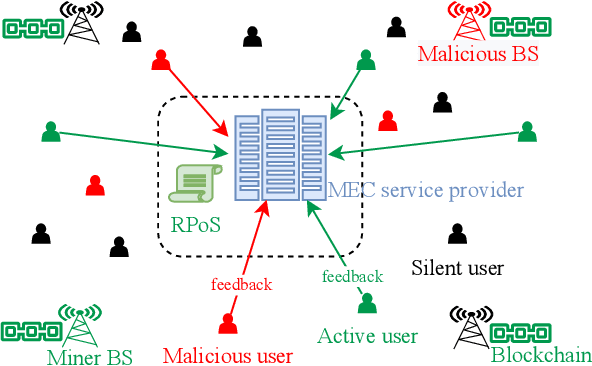
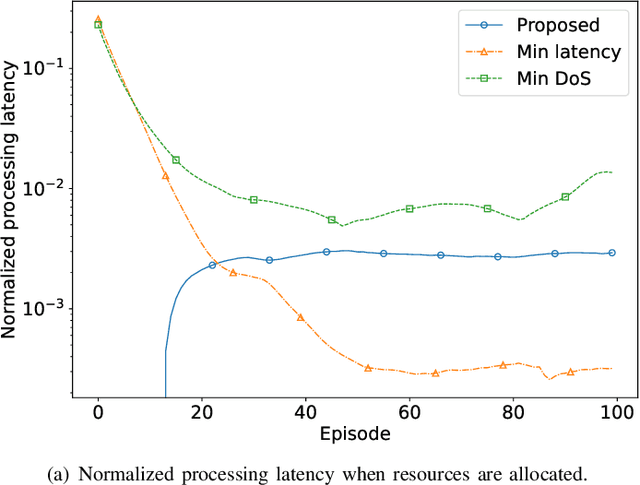
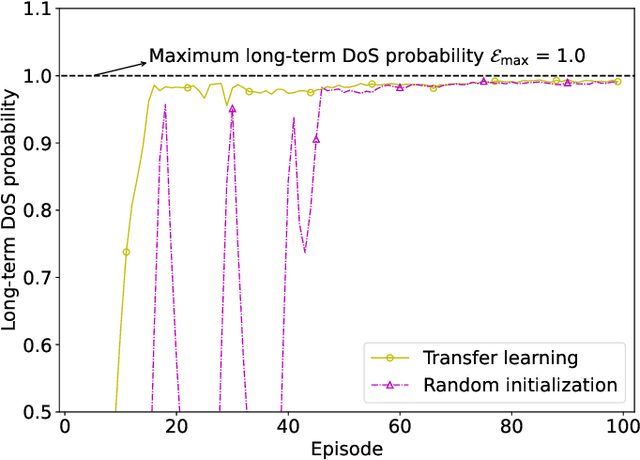
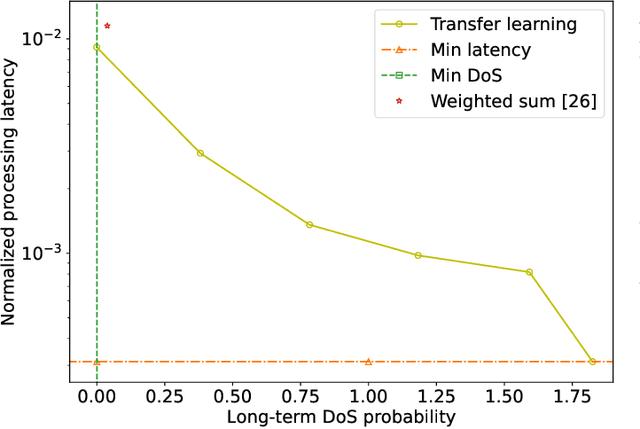
Abstract:This paper proposes a blockchain-secured deep reinforcement learning (BC-DRL) optimization framework for {data management and} resource allocation in decentralized {wireless mobile edge computing (MEC)} networks. In our framework, {we design a low-latency reputation-based proof-of-stake (RPoS) consensus protocol to select highly reliable blockchain-enabled BSs to securely store MEC user requests and prevent data tampering attacks.} {We formulate the MEC resource allocation optimization as a constrained Markov decision process that balances minimum processing latency and denial-of-service (DoS) probability}. {We use the MEC aggregated features as the DRL input to significantly reduce the high-dimensionality input of the remaining service processing time for individual MEC requests. Our designed constrained DRL effectively attains the optimal resource allocations that are adapted to the dynamic DoS requirements. We provide extensive simulation results and analysis to} validate that our BC-DRL framework achieves higher security, reliability, and resource utilization efficiency than benchmark blockchain consensus protocols and {MEC} resource allocation algorithms.
Hybrid NOMA assisted Integrated Sensing and Communication via RIS
Sep 12, 2023Abstract:This paper investigates the optimization of reconfigurable intelligent surface (RIS) in an integrated sensing and communication (ISAC) system. \red{To meet the demand of growing number of devices, power domain non-orthogonal multiple access (NOMA) is considered. However, traditional NOMA with a large number of devices is challenging due to large decoding delay and propagation error introduced by successive interference cancellation (SIC). Thus, OMA is integrated into NOMA to support more devices}. We formulate a max-min problem to optimize the sensing beampattern \red{with constraints on communication rate}, through joint power allocation, active beamforming and RIS phase shift design. To solve the non-convex problem with a non-smooth objective function, we propose a low complexity alternating optimization (AO) algorithm, where a closed form expression for the intra-cluster power allocation (intra-CPA) is derived, and penalty and successive convex approximation (SCA) methods are used to optimize the beamforming and phase shift design. Simulation results show the effectiveness of the proposed algorithm in terms of improving minimum beampattern gain (MBPG) compared with other baselines. Furthermore, the trade-off between sensing and communication is analyzed and demonstrated in the simulation results.
Weighted Sum Age of Information Minimization in Wireless Networks with Aerial IRS
Mar 09, 2022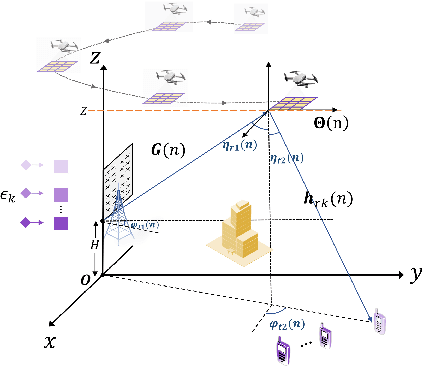
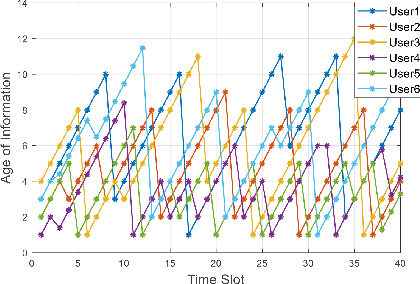
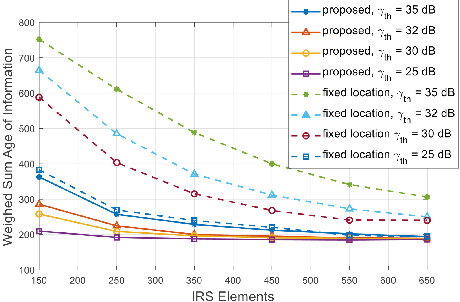
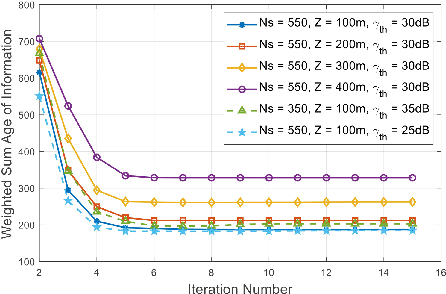
Abstract:In this letter, we analyze a terrestrial wireless communication network assisted by an aerial intelligent reflecting surface (IRS). We consider a packet scheduling problem at the ground base station (BS) aimed at improving the information freshness by selecting packets based on their AoI. To further improve the communication quality, the trajectory of the unmanned aerial vehicle (UAV) which carries the IRS is optimized with joint active and passive beamforming design. To solve the formulated non-convex problem, we propose an iterative alternating optimization problem based on a successive convex approximation (SCA) algorithm. The simulation results shows significant performance improvement in terms of weighted sum AoI, and the SCA solution converges quickly with low computational complexity.
 Add to Chrome
Add to Chrome Add to Firefox
Add to Firefox Add to Edge
Add to Edge